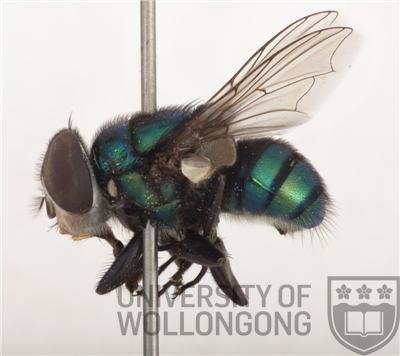Taxonomy
Family: Calliphoridae
Subfamily: Chrysomyinae
Genus: Chrysomya Robineau Desvoidy 1830
Species: rufifacies (Macquart 1843)
The first-instar larva was described by Liu and Greenberg (1989) and O'Flynn and Moorhouse (1980). The second-instar larva was described by Erzinçlioglu (1984), Liu and Greenberg (1989) and O'Flynn and Moorhouse (1980). The third-instar was described by Erzinçlioglu (1984) and Holloway (1991). Liu and Greenberg (1989) described the egg and puparium.
Biology
Chrysomya rufifacies, also known as the hairy maggot blowfly, is a common species of forensic and agricultural importance in Australia. The species is largely considered a secondary carrion fly, however, in northern areas it may behave as a primary species (O'Flynn and Moorhouse 1979). It prefers to oviposit on sheltered areas of the carcass rather than on wounds.
Second- and third-instar larvae of this species may act as facultative predators of other dipteran larvae. The larvae have a tough, heavily sclerotized skin with spines, which give it a ‘hairy’ appearance. The tough skin also probably protects the larva from canabolism (Baumgartner 1993). The species will also strike sheep in Australia, although it acts mainly as a secondary myiasis fly and is probably incapable of initiating a strike. However, even as a secondary fly, it is extremely harmful to livestock due to it exacerbating strikes caused by other species (Shishido and Hardy 1969).
The larvae pupate either on the surface of the soil or on the carcass itself. This is thought to make them particularly susceptible to attack by parasitoid wasps, however, their thick pupal cases may provide them with some protection (Baumgartner 1993). The larval development of the species has been studied by O’Flynn (1983) and Byrd and Butler (1997).
Distribution
Chrysomya rufifacies is common throughout Australia and has been recorded in all Australian states and territories. Chrysomya rufifacies is likely to be absent from some areas during winter, particularly in the southern areas of its range.
Relevant Literature
Baugartner, D.L. (1993) Review
of Chrysomya
rufifacies (Diptera: Calliphoridae).
Journal of Medical
Entomology 30, 338-352.
Byrd, J.H. and
Butler, J.F. (1997) Effects of temperature on Chrysomya
rufifacies (Diptera: Calliphoridae)
development. Journal of Medical Entomology 34,
353-358.
Erzinçlioglu,
Y.Z. (1984) Studies on the
morphology and taxonomy of the immature stages of
Calliphoridae, with analysis of phylogenetic relationships
within the family, and between it and other groups in the
Cyclorrhapha (Diptera). Ph.D., University of Durham.
Fuller,
M.E. (1932) The larvae of the Australian sheep blowflies. Proceedings of the
Linnean Society of New South Wales 57, 77-91.
Fuller,
M.E. (1934) The insect inhabitants of carrion:
a study in animal ecology. Council for Scientific and Industrial Research,
Australia, Bulletin 82, 1-63.
Holdaway,
F.G. (1933) The synonymy and distribution of Chrysomyia rufifacies
(Macq.), an Australian sheep blowfly. Bulletin of
Entomological Research 24,
549-560.
Holloway, B.A. (1991)
Identification of third-instar larvae of flystrike and
carrion-associated blowflies in New Zealand (Diptera:
Calliphoridae). New
Zealand Entomologist 14, 24-28.
Mackerras,
I.M. (1937) The sheep blowfly problem in
Australia. Results of some recent investigations. Council for Scientific
and Industrial Research. Pamphlet 66, 1-39.
Mackerras,
I.M. and Fuller, M.E. (1937) A survey of the Australian
sheep blowflies. Journal
of the Council for Scientific and Industrial Research 10, 261-270.
Norris,
K.R. (1959) The ecology of sheep blowflies in Australia. In: Keast, A.,
Crocker, R L. and Christian, C.S. (eds.) Biogeography and
Ecology in Australia. DW. Junk, Netherlands.
O'Flynn,
M.A. (1983) The succession and rate of development of
blowflies in southern Queensland and the application of
these data to forensic entomology. Journal of the
Australian Entomological Society 22, 137-148.
O'Flynn,
M.A. and Moorhouse, D.E. (1979) Species of Chrysomya as primary
flies in carrion. Journal of the
Australian Entomological Society 18, 31-32.
O'Flynn, M.A. and
Moorhouse, D.E. (1980) Identification of early immature
stages of some common Queensland carrion flies. Journal of the
Australian Entomological Society 19, 53-61.
Roy,
D.N. and Siddons, L.B. (1939) On the life history and
bionomics of Chrysomyia
rufifacies Macq. (Order Diptera,
Family
Calliphoridae). Parasitology
31, 442-447.
Shishido, W.H.
and Hardy, D.E. (1969) Myiasis of new-born
calves in Hawaii. Proceedings of the Hawaiian
Entomological Society 20, 435-438.



